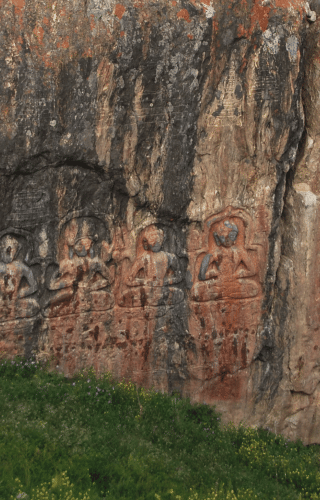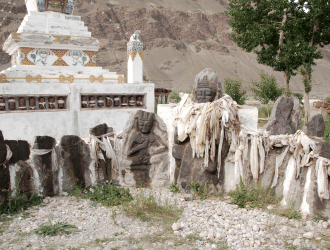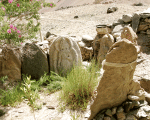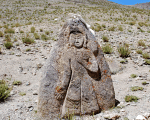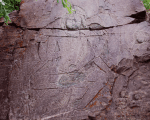Buddhist rock carvings are scattered throughout Ladakh, which in their style and iconography resemble the rock carvings prior to the influence of Tibetan art in the region, broadly reflecting a strong influence of the Kashmiri sculpture tradition. Further, they reflect an infallible blend of degenerated provincial Gupta art with the Gandharan style. The Buddhist divinities represented here are clearly of Indian origin, and for iconographic reasons as well as their comparison with bronzes of the time, they are unlikely to date from much earlier than the eighth century. It is to the eighth to eleventh centuries that we may attribute these Buddhist rock reliefs which represent the most important traces of direct Indian Buddhist influence in Ladakh that predate Tibetan Buddhist influence in the region.
These images present themselves as being made by highly skilled craftsmen who had an aesthetic command of their vision and material. There is a harmonious balance in the relative proportions of the limbs and appendages, the garments and the ornaments. The harmonious and pleasing details on the front of the figures contrast with the extremely shallow carvings of the later period, which can be seen even on rock slabs placed over the mani (prayer) walls. As it is commonly recognised that Alchi sculptures are of Kashmiri origin, it can be assumed that these rock-carved figures were already a model for later artists. On this ground, an assumption can be made that the later sculptures in the early temples of Ladakh are the replicas of these carvings.
These complex rock carvings and inscriptions of Ladakh provide a remarkable source for the study of the cultural history of Central and South Asia. Unfortunately, many of these carvings are succumbing both to natural weathering and human activities. One fine example is the loss of the Kharosthi inscription from the second century AD, located at Khalatse, which was lost during the construction of the last two bridges. At another site at Takmachik, local residents remember the petroglyph site locally called ‘Sta dang Ga’ meaning ‘Horse and Saddle’ of the famous Gyalam Kesar from the Gesar Epic that lies near the bridge but has been eroded; it is also recalled as a famous junction where ‘dak [mail] runners’ handed over the mail they carried. At the same time, many individuals and organisations in Ladakh are working towards the conservation of these sites. The Rock Art Sanctuary at Domkhar is one such example, another is the community initiatives being carried out at Stok. Meanwhile, the Himalayan Cultural Heritage Foundation (HCHF) has also established a Rock Art Unit under which these important sites, as well as new sites, are in the process of being documented. Eventually, it is hoped that this will all add to the protection of these sites in the years to come.
